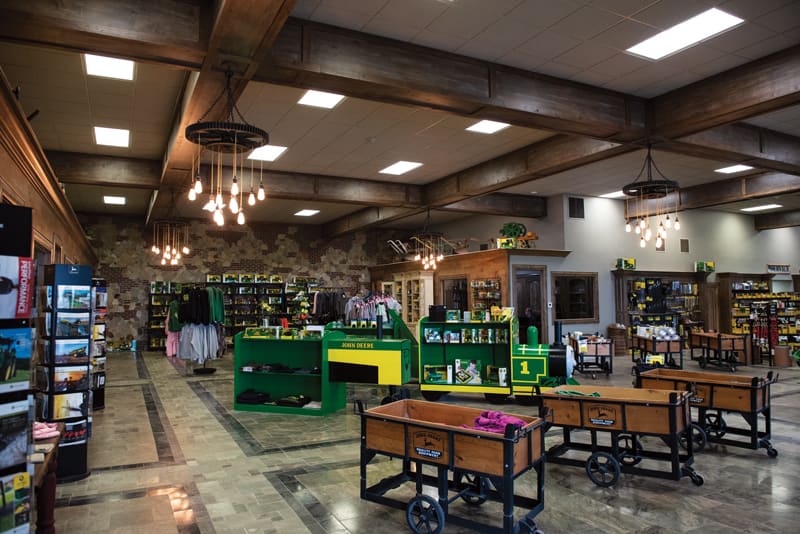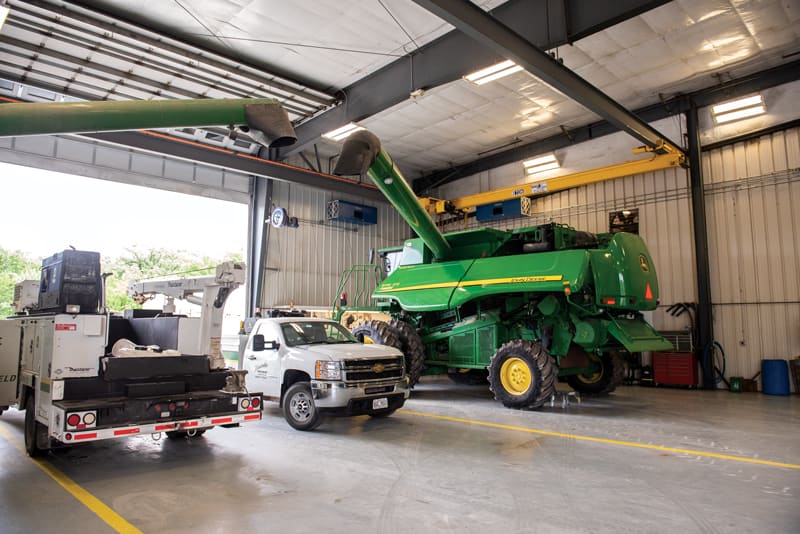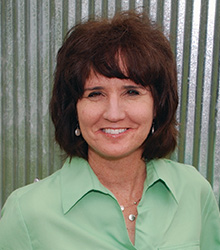
Larry Roeder had a newly earned Master’s Degree in economics, no retail experience and a passive investor when he purchased a farm equipment dealership in 1981 in Hiawatha, Kan. He was looking for a business opportunity and found one through a chance meeting with a John Deere territory manager.
He says this about the dealership’s beginnings, which was in the middle of an ag economy crisis: “The first 10 years were treading water, to just survive. Sixty-six percent of the dealerships within 150 miles closed within our first 20 years and then consolidations started.”
Roeder and his wife, Susan Sommers, who became a co-owner of Hiawatha Implement, survived that early crisis, assembled a young and progressive management team, built two impressive locations and in 2018, earned $87.5 million in sales, a return on assets of 9.11% and an absorption rate of more than 109%.
Hiawatha Implement with locations in Hiawatha, Kan., and Mound City, Mo., is Farm Equipment’s 2019 Dealership of the Year in the $75+ million in sales category.
Hiawatha Implement
Founded:1971 and purchased by Larry Roeder and his uncle, who was a passive investor, in 1981
Employees: 77
Owners: Larry Roeder and Susan Sommers
Locations: 2
2018 Revenues: $87.5 million
2018 Market Share: 83.94%
Return On Assets: 9.11%
2018 Parts & Service Absorption Rate: 109.35%.
Major Line: John Deere
Shortlines: MacDon Industries, New Leader Mfg., Unverferth Mfg., Brent, Wolverine Equipment, SRS and Hustler Turf
“The best thing about earning Dealership of the Year is I can tell my employees, ‘Isn’t this great what we have done together?’ It’s recognition for them — that’s the big thing. It’s about pride and motivation to keep doing what we’re doing,” Roeder says.
Hiawatha Implement
Video Interviews
Visit www.FarmDealerOfTheYear.com to watch exclusive videos with Hiawatha Implement. Filmed on location by Farm Equipment editors, these videos are sponsored by CDK Global Heavy Equipment.

In addition to John Deere, Hiawatha Implement also carries MacDon Industries, New Leader Mfg., Unverferth Mfg., Brent, Wolverine Equipment, SRS and Hustler Turf.
Defining the Customer Base
Hiawatha’s locations in northeast Kansas and northwest Missouri serve an agricultural customer that typically farms 2,000-8,000 acres, with some farming 10,000 acres or more. Roeder expect these farm sizes to remain about the same. “Two thousand to 8,000 acres is a very economical range to operate in and it already takes a boatload of money operate at that size,” he says.
Serving those operations are where Hiawatha shines, where it can focus on the bond between a producer and salesperson. And if that bond doesn’t happen? The producer is assigned a different salesperson. The customer is happy and there are no arguments about losing a sale or being forced to take on a certain customer because there are no sales commissions.
“The important thing is the salary has to be competitive to start with and realizing there are more important things than money to employees. You have to take an interest in what they are doing and give them compliments. But, in order for my system to work, you have to have competitive salespeople. During our monthly sales meetings, we pass around a list of the performance of the sales team. My salespeople want to be the best and I go to great lengths to encourage them,” Roeder says. Spurt incentives are given when inventory needs to be moved.
Mentoring the Team
Hiawatha’s management team includes corporate roles for sales, aftermarket, used equipment and integrated solutions management. Three have been promoted from within the business and one is a newer hire.

The parts department is designed to help customers and the team to work together, as opposed to being separated across a counter.
“One of the few solid assets we received with the purchase of our business was great employees, which made up for my lack of management. Employees are the intermediaries between management and customers. Over time, the business has basically evolved because of this relationship,” Roeder says.
He acts as a mentor to the managers, letting them make their own decisions, but providing overall direction. “I talk to them about what we're doing and why we're doing it and I ask them what they think. We don't always agree on everything,” he says.
During those times, he encourages his managers to try out their ideas. If they don’t work, Roeder and the team try to learn from the experience. “They learn something and I also learn something. They’re not afraid to open up to me and it’s a very productive relationship,” he says.
Meeting Goals
Roeder says he has a low-key in approach to business. “We're more price-takers than price-makers and don’t think we're going to change the world,” he says. However, that doesn’t mean that he and his team are not driven to succeed. For instance, they’ve embraced being a technology solutions provider.

Hiawatha Implement’s Mound City, Mo., location was remodeled and expanded in 2014, incorporating a vintage industrial theme. Susan Sommers, one of the owners, designed the building and acted as general contractor. She sourced vintage fixtures and found unique displays, such as ammunition carts that were refurbished into retail displays.
“Technology has given us the option of selling precision measurements, electronic control over machines and records, which has greatly modified and enhanced our original face and core of ‘selling iron.’ The importance of having employees being able to think similarly to what customers do is very important. Our Integrated Solutions’ department has a Certified Crop Adviser and for the last 2 years, we have sponsored an agronomy test plot that compares tillage, planting and fertilizing practices. The overlying goal is to maintain a leadership presence as one of the community’s agronomy leaders,” Roeder says.
Chad Gormley, sales manager, says, “The main attributor to our growth needs to be credited to the application of technology: GPS guidance, precision GPS application rates, seed spacing and depth control, yield monitoring, automated machine adjustments, off- site monitoring of equipment and cloud data management.” The sales team uses Handle CRM from CustomerTRAX and Sedona Technologies Sales Workflow to track sales.
Chris Krueger is the dealership’s Integrated Solutions Manager. He says the dealership works to maintain about 100 Agriculture Management Services (AMS) packages each year and they have about 120 RTK customers — both are above the dealership’s annual goals. They also have about 70% of their customers’ acres in the John Deere Operations Center, with John Deere’s goal being 40%.

A recent remodel at Hiawatha Implement’s Mound City, Mo., location included a 75 x 120 addition to the service department. Each bay has its own crane and several bays were expanded to accommodate large implements.
Roeder says the Integrated Solutions department is not a major profit center for the dealership, but necessary for its success. “We are cultivating our customers to need us through this technology. We don't make much money doing it, but we gain the customers confidence and we make them more money,” he says.
The aftermarket department has been a major revenue driver, however. Chad Derr, aftermarket manager, shares the service department’s goals: “We would like each tech to be at least 100% efficient and 90% productive. The reality with efficiency is some techs are going to be 120% and some 90%. I want to see each location at 100% efficient or above every month. The most important thing is the quality of work that the tech is performing,” Derr says.
Larry Roeder’s Top 3 Defining Moments

Larry Roeder owns Hiawatha Implement.
Larry Roeder, owner of Hiawatha Implement, is the recipient of the 2019 Farm Equipment Dealership of the Year in the $75+ Million in Sales category. He shares the top 3 defining moments of his career:
- I attended the 5th year reunion of my master’s class in 1986. All of my former classmates were successfully moving up their corporate ladders. I was achieving a small profit 4 out of 5 years that did not measure up well. I went home and started getting my resume ready and looking into exit plans for my business. By some coincidence, I received a free book in the mail from Deere & Co., “The First 150 Years of John Deere.” The book was as much about the history of agriculture as it was about the company — a boom and the following depression. The emphasis on cycles made me realize what a cyclical industry agriculture was. Because of this book, I decided the '80s were not agriculture’s first down cycle and most likely would not be the last, so I altered my decision.
- When trying to get permission to transfer stock from my silent partner, the message from Deere & Co. was quite explicit. Their goal was consolidation. My priorities were who could take the best care of my employees and customers. I did my best to minimize emotions and evaluated the numbers and came to the conclusion that my employees and customers deserve their current management. Should circumstances change, hopefully, I will be the first to observe the change and make the correct management decisions.
- My push has always been into motivating employees into taking care of our customers. Issues have come up lately with several employees’ health deteriorating to the point where there were major safety issues with their continued employment. The problem came to light when I found out the employees were so work motivated, they had no intention of leaving their work. Management has been refocused with more interest in employees’ personal lives.
The service department’s incentives are based on productivity and efficiency. “Efficiency falls directly on the tech, but by also using productivity, it gives the tech some ownership in making sure work is scheduled out ahead of them and that they communicate with the location managers on the progress of their jobs. Our techs can earn up to an additional $11.00 per billed hour based off their labor performance. These incentives are paid monthly,” Derr says.
The dealership has achieved a 109.35% absorption rate and Derr says standard job pricing has significantly improved the dealership’s aftermarket performance. “We believe in the idea of standard job pricing and the benefits to the company, techs and our customers. We now have a database of over 280,000 job codes. We also changed our incentive program so that it is tied directly to the benefits of standard job pricing. We are setting goals, we are sharing these goals with the entire aftermarket department, and we explain them to each employee,” Derr says.
Monthly incentives for the parts department are based off gross margin at each location that is then shared among all the parts employees. The dealership’s goal is a 32% margin on parts and they’ve focused on early order programs. This meant making room for additional inventory and spreading out delivery.
“To make room, we focused on lowering our zero sales a bit and utilizing the additional warehouse space we gained with the building improvements and additions. We have also focused on making sure we have value priced options to offer our customers by stocking more Reman and A&I Products offered through Deere,” Derr says.
Meeting Challenges
Hiawatha Implement is among those dealerships and their customers affected by major spring flooding. Roeder takes a common sense approach to dealing with these challenges. For instance, spring equipment sales are down, but he expects service revenue to increase from equipment that is repairing the damage to land and roads.
For those customers with newly purchased planting equipment, they’re working with John Deere to extend the warranty. And, they’re planning to deal with equipment that may be returned early off lease.
“I have witnessed three super booms in agriculture and I expect to see one more…”
— Larry Roeder of Hiawatha Implement
Michael Fangman is the used equipment manager and he says he is regularly talking with Gormley, the sales manager, and with Roeder about the level of used inventory, trade-in values and lease specials. They’ve had recent success with moving used combines — machines that offer producers a higher level of technology at a more affordable price.
Fangman has built a national network of used equipment wholesalers, including contacts in Australia, the Ukraine and South America. The dealership strives for a 3 times turn on used equipment. However, they know that goal is also tied to new equipment sales — more new sales means less used equipment sold.
Roeder relies on his records to put the flood in perspective. “When they started forecasting the flood for this year, I went back and looked at my records for 2011, 2 years prior and 2 years after that flood. I noticed a steady increase in parts and service, but no real fluctuation for that 5-year period. So then I quit worrying because the past normally predicts the future,” Roeder says.
Building Pride
The backdrop for the dealership’s achievements are two first-class facilities. In 2011, a new 40,000 square-foot store was built in Hiawatha and in 2014, the 26,000-square foot Mound City store was remodeled and expanded 75%, including a 75 x 120-foot addition to the service department.
Sommers took the lead on both projects, acting as designer and general contractor. To gather inspiration and ideas, the couple visited Harley Davidson stores, Cabelas stores and John Deere dealerships in the U.S. and while on vacation in Ireland and Peru. The Hiawatha store is inspired by European architecture and the entrance features a tower, equipped with slate roof and copper cupola. (Read a Farm Equipment feature about the Hiawatha facility.)
The Mound City store follows a vintage industrial theme. Roeder says they wanted to show their appreciation for their employees and give them a sense of pride. They invested in things like recliners for the technician’s break room and a 30 x 40 foot classroom with a 10 x 25 foot window that provides a view of 4 states.
What the Judges Say
The quality of their performance is demonstrated in the annual sales per employee, $1,136,250, and an excellent return on assets. They had excellent market penetration with an average market share of 84% and their parts/service absorption rate was outstanding at 109.35%.
Sommers describes the effort: “It was a three phase expansion that took about 13 months to complete. One of the major challenges was to minimize the disruption of daily work flow for the employees and maintain efficiency to service customer needs while adding 75% to the facility's size.
“A big design challenge was getting additional showroom ceiling height while maintaining the roof slope from the original building to the north addition. This goal was achieved by welding framework to the purlins, and wrapping it with plywood and battens to resemble large wooden beams spanning the width of the showroom. The design of the reception area's stone columns and arch is to conceal one of the original building's steel support columns.
“The ‘industrial’ concept was accentuated with a colored glass block inset in the exterior towers and columns, which is backlit at night for maximum visibility from the interstate. The ‘vintage’ portion of the design is evidenced in the showroom with antique tools, horse drawn implements and pair of 1930s John Deere B tractors above the parts counters. The steel platform that supports the 5,000 pound load was fabricated by technicians in our shop as were the iron railings, ‘bull gear’ chandeliers, and numerous display fixtures including Thomas the Train, Corny Cornpicker, and Johnny Tractor. It was truly a team effort which made the building process flow smoothly and efficiently, and one that all involved can be proud of.”
For all its “show,” serving customers is always top of mind. For instance, the Hiawatha store features a second entrance where customers can go directly to the parts or service departments. In Mound City, the parts department was designed so customers can talk alongside the parts staff, as opposed to being separated across a counter.
Evolving Leadership
Roeder says he has evolved over the years, as a person and a business owner. “I started as a cocky young college kid that knew is all. And I became humble in a hurry. I spend a lot of time reading history and biographies looking at what and why people succeeded,” he says.
Sommers’ take on the dealership’s success references Larry’s leadership and the employees, “My husband equates it to great ball team. All the great ball teams have great players and then all the new recruits want to come and work for a great team. That’s the environment that has been built,” she says.
Despite the challenges in agriculture, Roeder is optimistic. “The agriculture sector has a potential great card to play in the world’s future, especially if the world grows to 9 billion people. In my lifetime, I have witnessed three super booms in agriculture and I expect to see one more,” he says.







